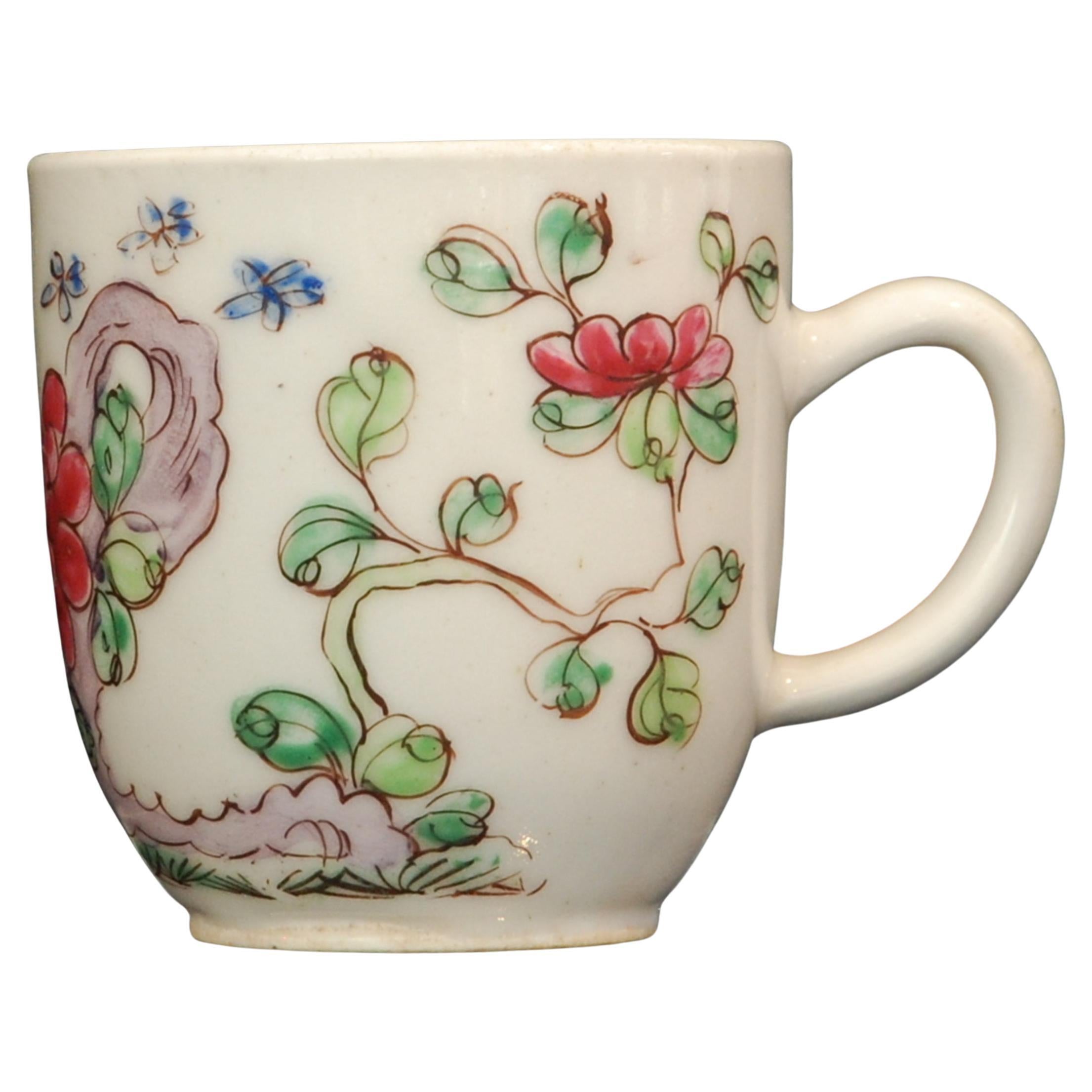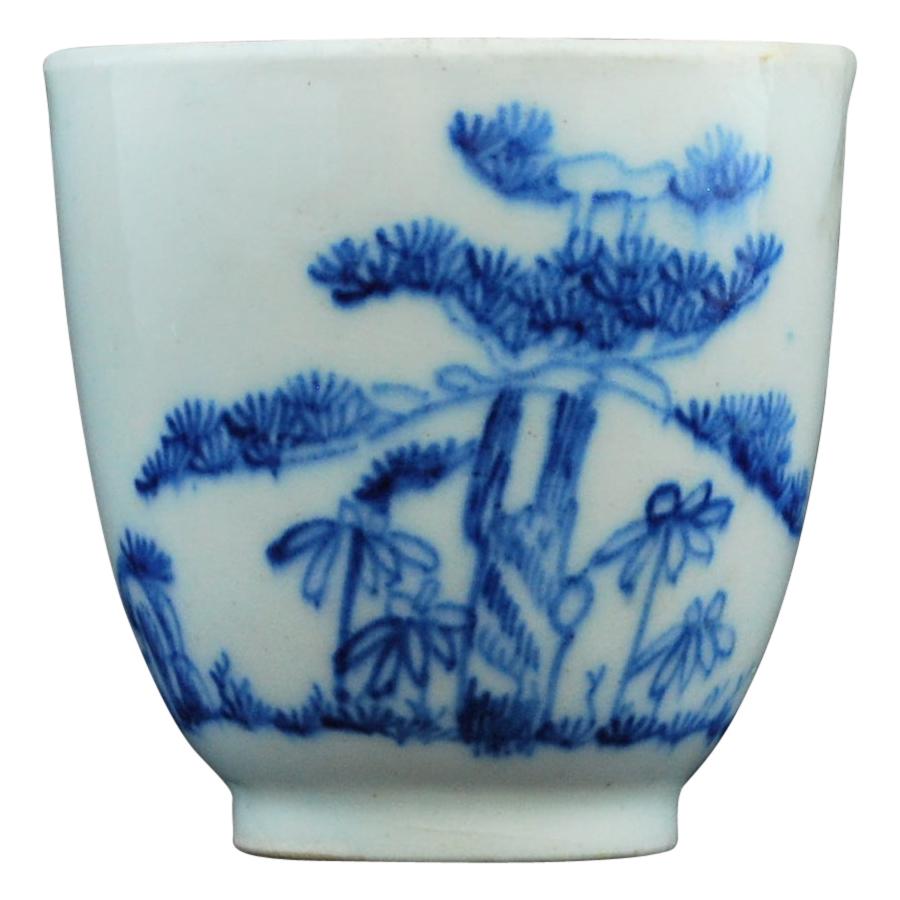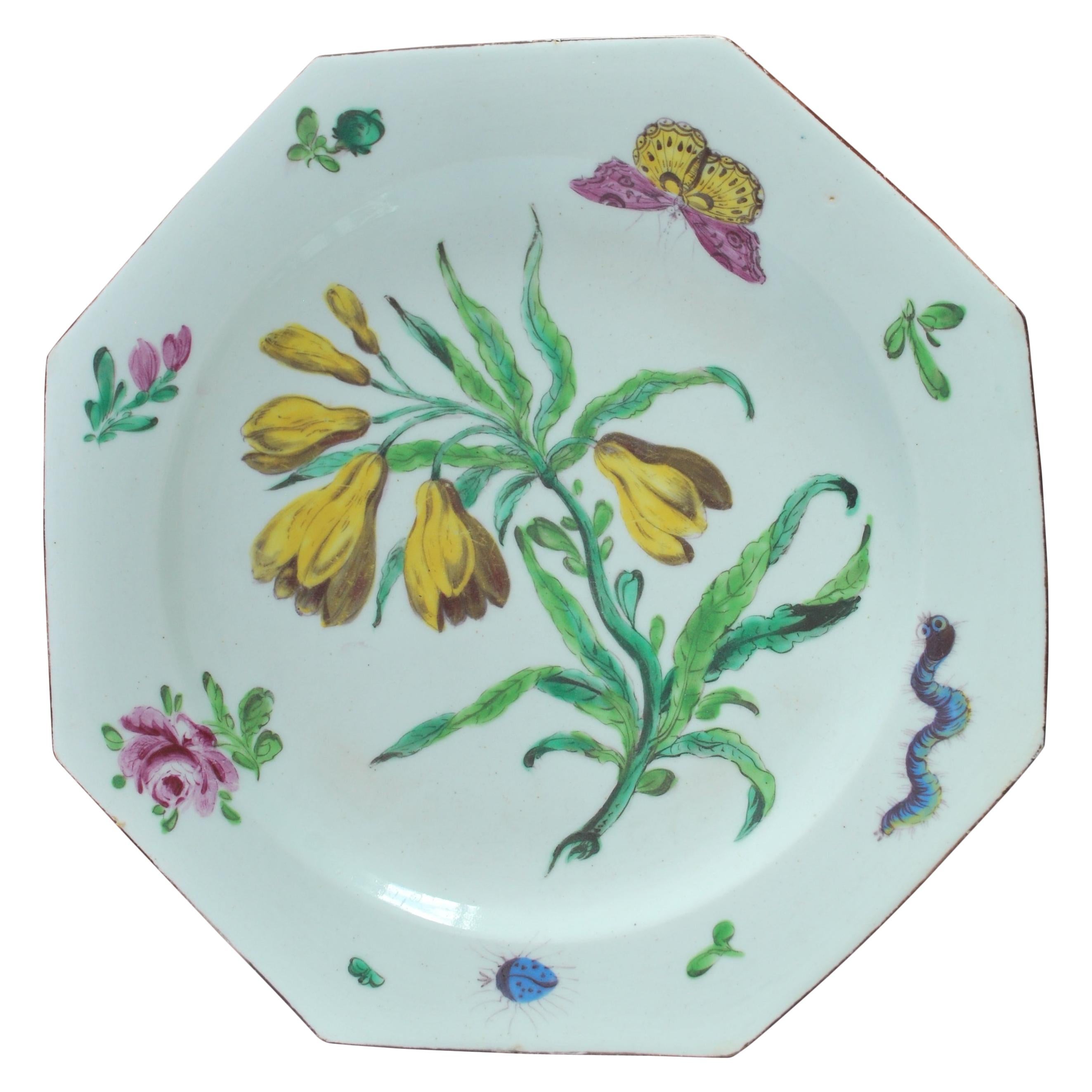Items Similar to Bow Porcelain Orphaned Coffee Cup, Famille Rose Peony, circa 1755
Want more images or videos?
Request additional images or videos from the seller
1 of 16
Bow Porcelain Orphaned Coffee Cup, Famille Rose Peony, circa 1755
About the Item
This is a very charming orphaned coffee cup made by the Bow Porcelain factory in about 1755. The cup is decorated in a Chinese "famille rose" peony pattern. This cup would have been part of a large tea service, and the tiny size shows how expensive coffee was in the 18th Century.
The Bow Porcelain Factory was one of the first potteries in Britain to make soft paste porcelain, and most probably the very first to use bone ash, which later got perfected by Josiah Spode to what is now the universally used "bone china". Bow was the main competitor of the Chelsea Porcelain Factory, but where Chelsea made very fine slipcast porcelain, Bow made a different soft paste porcelain that tended to be softer and could be pressed into moulds. Bow served a larger public generally at lower prices. The factory was only in operation between 1743 and 1774, after which the tradition got incorporated into some of the later famous potteries such as Worcester and Derby.
The cup is unmarked, which is normal for Bow items of this era.
Condition report the cup is in excellent condition without any damage or repairs. There are various glazing imperfections, which are quite normal for porcelain of this era.
Antique British porcelain is never perfect. Kilns were fired on coal in the 1800s, and this meant that china from that period can have some firing specks from flying particles. British makers were also known for their experimentation, and sometimes this resulted in technically imperfect results. Due to the shrinkage in the kiln, items can have small firing lines or develop crazing over time, which should not be seen as damage but as an imperfection of the maker's recipes, probably unknown at the time of making. Items have often been used for many years and can have normal signs of wear, and gilt can have signs of slight disintegration even if never handled. I will reflect any damage, repairs, obvious stress marks, crazing or heavy wear in the item description but some minor scratches, nicks, stains and gilt disintegration can be normal for vintage items and need to be taken into account.
There is widespread confusion on the internet about the difference between chips and nicks, or hairlines and cracks. I will reflect any damage as truthfully as I can, i.e. a nick is a tiny bit of damage smaller than 1mm and a chip is something you can easily see with the eye; a glazing line is a break in the glazing only; hairline is extremely tight and/or superficial and not picked up by the finger; and a crack is obvious both to the eye and the finger. Etcetera - I try to be as accurate as I can and please feel free to ask questions or request more detailed pictures!
Dimensions 5.75cm high (2.25").
- Creator:Bow Porcelain (Maker)
- Dimensions:Height: 2.25 in (5.72 cm)Diameter: 2.25 in (5.72 cm)
- Style:Rococo (Of the Period)
- Materials and Techniques:
- Place of Origin:
- Period:1750-1759
- Date of Manufacture:circa 1755
- Condition:Wear consistent with age and use. In excellent antique condition without any damage, repairs or crazing. Some production flaws in the glaze.
- Seller Location:London, GB
- Reference Number:
About the Seller
5.0
Platinum Seller
These expertly vetted sellers are 1stDibs' most experienced sellers and are rated highest by our customers.
Established in 2016
1stDibs seller since 2019
208 sales on 1stDibs
Typical response time: <1 hour
- ShippingRetrieving quote...Ships From: London, United Kingdom
- Return PolicyA return for this item may be initiated within 14 days of delivery.
More From This SellerView All
- Chamberlains Worcester Orphaned Coffee Cup, Sepia Flower Sprays, Georgian ca1795By Chamberlains WorcesterLocated in London, GBThis is a beautiful orphaned coffee cup made by Chamberlains Worcester in about 1795. The cup has a spirally fluted or shanked shape and is decorated...Category
Antique 1790s English George III Tea Sets
MaterialsPorcelain
- Derby Porcelain Coffee Cup, Artichoke Pattern in Turquoise, Georgian ca 1785By DerbyLocated in London, GBThis is a beautiful coffee cup and saucer made by Derby in about 1785. The set has the distinctive "artichoke" moulding and a bright turquoise ground with the white artichoke surface...Category
Antique 1780s English George III Tea Sets
MaterialsPorcelain
- Riley Coffee Cup, Gilt Chevron Zigzag Pattern, Regency, circa 1815By J&R RileyLocated in London, GBThis is a beautiful coffee cup and saucer made by Riley in about 1815, decorated in a striking gilt chevron pattern with a rather psychedelic zigzag effect. The John & Richard Ril...Category
Antique 1810s English Regency Porcelain
MaterialsPorcelain
- C.J.Mason Porcelain Coffee Cup, Chinoiserie Birds Red and Gilt, ca 1830By C.J. Mason 1Located in London, GBThis is a beautiful coffee cup and saucer made by C J Mason around 1830, which was the George IV era. The items are decorated with beautiful transfer printed birds and Chinoiserie de...Category
Antique 1830s English George IV Porcelain
MaterialsPorcelain
- Samuel Alcock Porcelain Coffee Cup, Orange Imari Flowers, Rococo Revival ca 1830By Samuel Alcock & Co.Located in London, GBThis is a beautiful coffee cup and saucer made by Samuel Alcock around 1830, which was the Rococo Revival era. The set is decorated with a bold Imari pattern and has a "ring-moulded" shape. Samuel Alcock was one of the many potters in Staffordshire such as Spode, Coalport, H&R Daniel and many others during the 1830s and 1840s. He was perhaps not the most well-known of potters but produced very high quality wares and original designs, often standing out for their bright choice of colours and beautiful shapes. The Alcock factory is not well documented so although they had a huge output, items are often mis-identified and we don't know much about the production process of artists, even though the wares have a very high quality that equals that of the more well known factories. The Rococo style was originally a style of the 18th Century. After the Baroque style, which was highly symmetrical and well-designed as it aimed to express the perfection of God, the Rococo style was a reaction that expressed the unpredictability and flow of nature. "Rococo" is derived from the French word "rocaille", which stands for a mass of pebbles that are self-organised in a completely unpredictable mess, for instance on the beach or in the mountains. Rococo moved away from the stranglehold that religion had on the arts: it was capricious, asymmetrical, charming and worldly. As Europe got mired in various wars between Germany, France and Britain, the general style got much more austere again and people embraced neo-classicism. But in the 1830s and 1840s, the seemingly unlimited fortunes of the Industrial Revolution sparked a revival of Rococo, once again creating natural shapes that are not always symmetrical and don't particularly make rational sense. This coffee cup can...Category
Antique 1830s English Rococo Revival Tea Sets
MaterialsPorcelain
- Spode Orphaned Porcelain Saucer, Chinoiserie Gilt Potted Flowers, Regency ca1820By SpodeLocated in London, GBThis is a beautiful deep orphaned saucer made by Spode around 1820. The saucer is decorated with a gorgeous Chinoiserie pattern of a group of potted flowers in gilt and grey. The sau...Category
Antique 1820s English Regency Porcelain
MaterialsPorcelain
You May Also Like
- Coffee Cup with Famille Rose decoration, Bow Porcelain, circa 1750By Bow PorcelainLocated in Melbourne, VictoriaA direct copy of a Chinese shape, decorated with chinoiserie painting of typical motifs in the famille rose palette.Category
Antique Mid-18th Century English Chinoiserie Porcelain
MaterialsPorcelain
- Famille Rose Tea Bowl & Saucer, Bow Porcelain Factory, circa 1755By Bow PorcelainLocated in Melbourne, VictoriaA delicate tea-bowl and saucer, decorated after the Chinese in the Famille Rose palette. This style of painting, known as 'wet enamelling', is very attractive but quite scarce in Bow...Category
Antique Mid-18th Century English Chinoiserie Porcelain
MaterialsPorcelain
- Coffee Cup, Bow Porcelain Factory, circa 1749By Bow PorcelainLocated in Melbourne, VictoriaOf Chinese export form with loop handle; the body imaginatively painted in a bright ‘early blue’ underglaze with pine, rock and bamboo after the Chinese. Yellow tinged body; clear gl...Category
Antique Mid-18th Century English Rococo Porcelain
MaterialsPorcelain
- Autumn, Bow Porcelain Factory, circa 1755By Bow PorcelainLocated in Melbourne, VictoriaFrom a series of figures representing The Four Seasons, Autumn is shown as a young man squeezing grapes into a cup, symbolic of harvest time, and recalling classical representations ...Category
Antique Mid-18th Century English Neoclassical Porcelain
MaterialsPorcelain
- Coffee Can, Blue and White "Residence", Bow Porcelain, circa 1755By Bow PorcelainLocated in Melbourne, VictoriaAn early coffee can, painted in under-glaze blue with a large residence in a Chinese landscape. Prov: Taylor Collection; Watney Collection.Category
Antique Mid-18th Century English Chinoiserie Porcelain
MaterialsPorcelain
- Botanical Plate, Bow Porcelain Factory, circa 1755By Bow PorcelainLocated in Melbourne, VictoriaA fine octagonal plate painted in the botanical style; possibly the yellow gloriosa climbing lily. Provenance: Taylor Collection; Robyn Robb 2003. Filled edge chips.Category
Antique Mid-18th Century English Neoclassical Porcelain
MaterialsPorcelain
Recently Viewed
View AllMore Ways To Browse
Large Bow
Antique Coffee Items
Antique Coffee And Tea
Bow Maker
Antique Porcelain Tea Cups
Antique Porcelain Tea Cup
Coffee Tea Set Porcelain
Vintage Silver Coffee Set
Antique Coffee Makers
Antique Coffee Maker
Antique Coffe Maker
Antique China Tea Sets
Antique China Tea Set
China Tea Sets Antique
Chinese Tea Sets Antique
Antique Chinese Tea Sets
Antique Chinese Tea Set
18th Tea Antique





